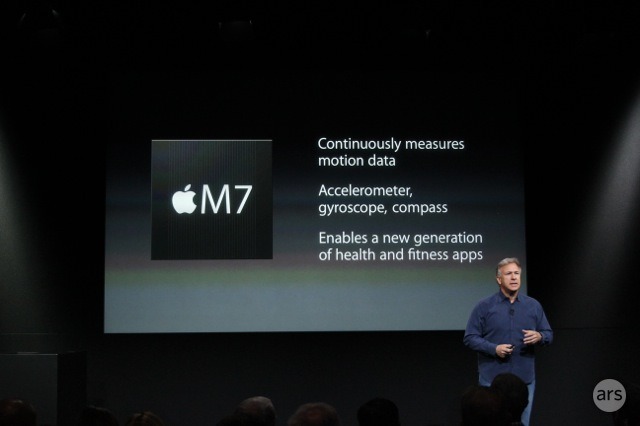the big announcement today is the m7 ars

The big announcement today is the M7. Ars summarizes:
The chip “continuously measures motion data,” and includes an accelerometer, gyroscope, and compass, Apple said. The chip measures and captures data from sensors without waking the A7 up, while a new API named “CoreMotion” identifies the user’s movement and makes “optimizations based on contextual awareness.”
A few thoughts:
1. There’s no greater argument for a watch than the introduction of the M7.
Being able to keep the A7 spun down while monitoring movement history is a big win for the ever battery impacted smartphone. However, the M7 isn’t a benefit but an enabler for a smart watch, which will require a multi-day battery life (I would be shocked if Apple shipped a watch with anything less than a 5 day battery life.)
Further, Apple has a history of piloting tech in niche products (which I imagine the 5S will become compared to the 5C) to weed out bugs and build reliable, scaled assembly lines without mass pressure. Consider the SSD in the initial MacBook Air, the large Retina display in the clumsily named MacBook Pro with Retina Display, or the pre-Bondi transparent plastic in the eMate. Shipping the M7 in the 5S boots up and scales the fab lines, begins accruing test data, and weeds out software bugs – all factors Apple would like mitigated prior to the big splash launch of a watch.
2. Fitbit needs to start acting like Netflix.
Consider the intro Austin Carr wrote in Fast Company wrote about the birth of Roku:
It was December 2007, and the device was just weeks away from launching. Yet after all the years and resources and talent invested in the project (a team of roughly 20 had been working on it around the clock, from ironing out the industrial design and user interface to taking trips to Foxconn to finalize production details), Netflix CEO Reed Hastings was having serious second thoughts. The problem? Hastings realized that if Netflix shipped its own hardware, it would complicate potential partnerships with other hardware makers. “Reed said to me one day, ‘I want to be able to call Steve Jobs and talk to him about putting Netflix on Apple TV,’” recalls one high-level source. “’But if I’m making my own hardware, Steve’s not going to take my call.’”
To the surprise of most employees at the company, Hastings decided to kill The Netflix Player, and spin the team out as a separate company. His decision, made almost exactly five years ago this month, was one of the riskiest moves in Netflix’s history. But it also proved to be one of Hastings’ most prescient. By shelving its hardware and remaining an agnostic platform, Netflix was able to transform itself into a digital powerhouse and become the dominant player in subscription streaming video. Its service is now ubiquitous, accessible on computers, smartphones, tablets, Internet-connected TVs, Blu-ray players, set-top boxes, and video game consoles.
Every morning I pocket my keys and wallet, strap on my Pebble, clip on my Fitbit, and grab my phone. Three out of the five objects I carry everyday can count my steps (though the Pebble’s ability is currently latent). If Fitbit wants to survive going forward they should abandon hardware and build the best software for Android, iOS, and whatever is next. The M7 will spur apps upon apps which will put pressure on Fitbit. That it was Nike on stage and not Fitbit is worrying.
3. Human-Machine interfaces are being further blurred.
Apps can now more granularly utilize a person’s movements. Not just where they are, but how they’re moving. Context from around the device is bleeding through the hardware.
The iPhone 5S takes your fingerprint every time you wake it.
Siri is getting better and can now utilize Wikipedia as a collective brain. Talking to the 5S might eventually become practical.
It’s not hard to imagine a future where the line between human and device becomes softer, especially as Apple emphasizes health applications with the 5C.
Will the next home button log my body temperature? Will movement processing become more nuanced, able to tell when my step alters beyond my habits to notice a pulled muscle or worn down shoe? Will the new facial recognition APIs translate smiles into emoji within iMessage?
Our phones know more about us every year.